
Portrait Gallery of Distinguished American Citizens, with Biographical Sketches, and Fac-similes of Original Letters. By William H. Brown.
Hartford [Connecticut, USA]: Published by E. B. and E. C. Kellogg. MDCCCXLVI [1846].
Folio, 27 sepia-tinted lithographic portraits in silhouette, plus facing facsimile of an autograph letter by the sitter (complete); including frontispiece of George Washington with facsimile of his letter to Gov. Jonathan Trumbull, May 15, 1784. 111 pp., original dark brown cloth boards backed with black morocco; the upper cover stamped in gilt with title and an image of a seated man examining a book. Binding a little scuffed and rubbed; some foxing to text leaves and spotting and browning to plate margins, as usual. Creasing through upper left corner of frontispiece; generally a good copy.
The subjects are Washington, John Marshall, John Quincy Adams, Richard Channing Moore, Andrew Jackson, John Forsyth, William Henry Harrison, John Caldwell Calhoun, De Witt Clinton, Richard Mentor Johnson, Joel Roberts Poinsett, Alexander Macomb, Martin Van Buren, Samuel Lewis Southard, Henry Clay, Henry Alexander Wise, Thomas Hart Benton, John Tyler, Levi Woodbury, Thomas Cooper, Daniel Webster, William White, Silas Wright, Nathaniel Potter Tallmadge, Felix Grundy, Dixon Hall, Lewis, and John Randolph. William Henry Brown (1808 - 1883), born in Charleston, South Carolina, was widely celebrated for his scissor-cut silhouettes. He wandered all over the United States, tracking down statesmen and distinguished citizens and taking their profiles. All the portraits, except for the George Washington allegorical frontispiece, are based on sketches made from life by Brown. This book was originally issued in 1845, but Harry Peters states that: "Almost the entire edition was destroyed by fire, and copies are extremely rare." See Library of Congress 06010172 for an 1845 edition.
[Ref: 20881] £1,850.00
view all images for this item
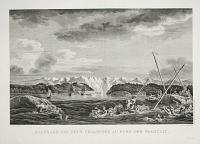
Naufrage des deux chaloupes, au Port des Francais.
Dessine par N. Ozanne. Gravé par Dequevauviller. L.Aubert scripsit.
[Paris: L'Imprimerie de la Republique, An V, 1797.]
Engraving. 390 x 560mm, 15½ x 22". Crease through middle of image.
Some of La Perouse's crew in trouble in the icy waters of Lituya Bay, Alaska (now part of the Glacier Bay Park & Wilderness), after the capsizing of two cutters, resulting in twenty-one deaths. In normal circumstances the waters are incredibly dangerous, with the spill of three glaciers entering the bay and a tidal difference of 10 feet; but in 1958 a megatsunami was recorded in the bay that destroyed trees to a height of 1,720 feet above sea-level, signifying a wave higher than the Empire State Building. In 1785 Jean-Francois de Galaup, comte de La Pérouse (1741-88) was sent by the French to continue Cook's exploration work in the Pacific, in the ships 'Astrolabe' & 'Boussole'. After three years, during which time he visited Chile, California, Alaska, Kamchatka, the Philippines, Japan and Hawaii, he travelled to Australia. Outside Botany Bay he met up with Captain Arthur Phillip's First Fleet, after which he set sail and was never seen again, despite an extensive rescue mission. Fortunately La Pérouse took every oportunity to send his work back to France: one crew member disembarked here at Petropavlovsk and spent a year crossing Russia back to France; later journals, charts and letters he left with the British at Botany Bay. Thus his discoveries were not lost with him, but published posthumously in this work, 'Voyage de la Perouse autour du monde..'.
[Ref: 45839] £520.00
![[Schooner Yacht America off Dunnose Isle of Wight.]](img-thumbnail/jpegs/44722.jpg)
[Schooner Yacht America off Dunnose Isle of Wight.]
[Joseph Miles Gilbert. G. E. Hicks.]
[Rowney & Co.][n.d., c.1851.]
Lithograph, rare. Sheet: 345 x 305mm (13½ x 12"). Pin holes, damage and surface dirt.
A marine scene showing the Schooner Yacht 'America' sailing off the coast of the Isle of Wight in 1851. 'America', built by a syndicate of members of the New York Sailing Club, won the Royal Yacht Squadron's race around the Isle of Wight, and was awared the '£100 Cup'. Now known as 'The America's Cup', it is the oldest international sporting trophy.
[Ref: 44722] £450.00
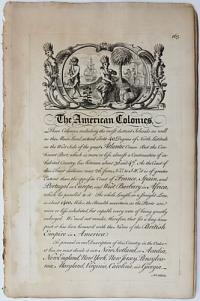
The American Colonies.
[Drawn and engraved by George Bickham.]
[n.d., 1748.]
Extract, disbound, 21 engraved plates, numbered 165-185. Each c. 260 x 160mm (10½ x 6¼"). Some damp staining and wear to edges.
Twenty-one pages of engraved-text description of the American colonies (fourteen with illustrations), including New York, New England, Pennsylvania, Maryland, Virginia and Carolina, published in George Bickham's 'The British Monarchy or a Chorographical Description of all the Dominions Subject to the King of Great Britain'. One of Bickham's interests was calligraphy, so the text is engraved with great verve.
[Ref: 45950] £950.00
view all images for this item
![[American Revolution.] A New and Accurate Map of the Chief Parts of South Carolina, and Georgia, from the Best Authorities.](img-thumbnail/jpegs/43272.jpg)
[American Revolution.] A New and Accurate Map of the Chief Parts of South Carolina, and Georgia, from the Best Authorities.
Jn.o Lodge sculp.
London, Published as the Act directs, 30th June 1780, by J. Bew, Pater Noster Row.
Engraved map. Sheet 285 x 390mm (11¼ x 15½"). Trimmed close to neatline lower right for binding, folds.
A contemporary map of the theatre of the Revolutionary War around Charleston, as Sir Henry Clinton and Charles Cornwallis were besieging the city. Major General Benjamin Lincoln surrendered Charleston and 5,000 troops on 12th of May, less than seven weeks before this map was published. Published in the 'Political Magazine', a monthly newspaper. The accompanying text is available at: https://babel.hathitrust.org/cgi/pt?id=mdp.39015067321755;view=1up;seq=479
[Ref: 43272] £480.00
![[American Revolution.] An Accurate Map of Rhode Island,](img-thumbnail/jpegs/43271.jpg)
[American Revolution.] An Accurate Map of Rhode Island, Part of Connecticut and Massachusets, shewing Admiral Arbuthnot's Station in Blocking up Admiral Ternay.
Jn.o Lodge sculp.
London, Published as the Act directs, Nov.r 30th 1780, by J. Bew, Pater Noster Row.
Engraved map. Sheet 290 x 400mm (11½ x 15¾") Trimmed close to neatline lower left for binding, folds and some creasing.
A contemporary map of the theatre of the Revolutionary War in the Carolinas, centred on Newport, where Admiral Mariot Arbuthnot was blockading the naval forces of the 'Expédition Particulière', the Comte de Rochambeau's French army sent to help the Americans. The chevalier de Ternay died during the blockade (two weeks after this map was published), but in July the following year the French marched south to join Washington's army in the decisive Yorktown campaign. Published in the 'Political Magazine', a monthly newspaper. The accompanying text is available at: https://babel.hathitrust.org/cgi/pt?id=mdp.39015067321755;view=1up;seq=479
[Ref: 43271] £420.00
![[American Revolution.] A New and Accurate Map of the Province of New York](img-thumbnail/jpegs/43269.jpg)
[American Revolution.] A New and Accurate Map of the Province of New York and Part of the Jerseys, New England and Canada, Shewing the Scenes of our Military Operations during the present War. Also the New Erected State of Vermont.
Jn Lodge sculp.
London, Published as the Act directs, Oct.r 31st 1780, by J. Bew, Pater Noster Row.
Engraved map. Sheet 390 x 290mm (15¼ x 11½"). Trimmed to neatline lower left for binding, folds.
A contemporary map of the theatre of the Revolutionary War in the north east, from the St. Lawrence River and Lake Champlain down to Long Island and west to Lake Ontario. Despite the military subject (it marks Ticonderoga, Saratoga and Bennington) the map also shows the boundary disputes between the provinces, particularly between New York, Vermont and New Hampshire. Published in the 'Political Magazine', a monthly newspaper. The accompanying text is available at: https://babel.hathitrust.org/cgi/pt?id=mdp.39015067321755;view=1up;seq=479
[Ref: 43269] £480.00
![[American Revolution.] A New and Accurate Map of Virginia,](img-thumbnail/jpegs/43273.jpg)
[American Revolution.] A New and Accurate Map of Virginia, and Part of Maryland and Pennsylvania.
Jn.o Lodge sculp.
London, Published as the Act directs, 31st December 1780, by J. Bew, Pater Noster Row.
Engraved map. Sheet 285 x 390mm (11¼ x 15½"). Trimmed close to neatline lower right for binding, folds.
A contemporary map of the theatre of the Revolutionary War in Virginia, showing west to the Alleghany Mountains, the south parts of New Jersey and Philadelphia. The month this map was published Benedict Arnold had led a force of 1,600 troops into Virginia; less than a week later Arnold burned Richmond. Also marked on the map are events from the French-Indian Wars, including forts Duquesne & Necessity; next to Fort Necessity is ''Washington taken here 1754'', a reference to the future president's only military surrender. Published in the 'Political Magazine', a monthly newspaper. The accompanying text is available at: https://babel.hathitrust.org/cgi/pt?id=mdp.39015067321755;view=1up;seq=479
[Ref: 43273] £480.00
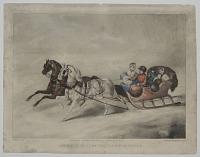
American Mode of Travelling in Winter.
J.M.Burbank del.t. Printed by L.M.Leferre, Newman St.
Published by L.Burbank, 18, York Terrace, Camberwell New Road [n.d., c.1840].
Very rare lithograph, with hand colour. Image 200 x 280mm (8 x 11"). Scrapes, filled worm holes, and closed tears; creased.
A horse-drawn sleigh transports a family through a wintry American landscape.
[Ref: 25933] £95.00
(£114.00 incl.VAT)
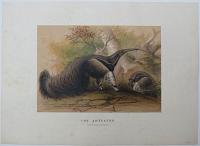
The Anteater. Myrmecophaga Jubata.
[Lithographed by Joseph Smit after Joseph Wolf.]
[London: Henry Graves & Company, 1861-1867.]
Coloured lithograph, trimmed to image and mounted on card with gilt title, as issued. Printed area 240 x 350mm (9½ x 13¾"). Backing card spotted.
A pair of giant anteaters, natives to central and South America. From 'Zoological Sketches by Joseph Wolf. Made for the Zoological Society of London, from animals in their vivarium, in the Regent's Park', issued in two parts, 1861 and 1867. Joseph Wolf (1820-99), a German artist, specialized in natural history illustration, and is considered one of the great pioneers of wildlife art, having depicted animals accurately in lifelike postures. He worked with John Gould on 'The Birds of Great Britain'. Sir Edwin Landseer considered him 'without exception, the best all-round animal artist who ever lived'.
[Ref: 45776] £190.00
(£228.00 incl.VAT)
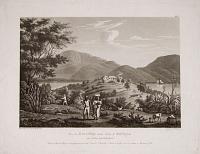
Vue de Gracebay dans l'Isle d'Antigoa aux Indes occidentales
Dess. d'ap. nat: par L. Stobwasser. gravé par Hurlimann.
Publié au profit des Missions Evangéliques par une Societé d'amis de l'Evangile, à Basle en Suisse, sous la direction de Birman & Fils. [n.d., 1830.]
Aquatint. 255 x 340mm (10 x 13½").
A very scarce view of Antigua, showing Grace Bay, a Moravian church founded on Antigua in 1791. The view was drawn by the Rev. L. Stobwasser for his 'Vues des établissements missionnaires fondés par la communauté évangélique des Frères-Unis'. This work was commissioned by the Moravian Church to promote their work on the island, which was the education of the Negro slaves, including teaching them to read. According to Stobwasser, 'By degrees, the prejudices of the planters against the Negro children being taught to read, which in the beginning were very perceptible, wore away... [giving] the prospect of happier days for the Negros'. [Letter from Stobwasser, quoted by The Religious Intelligencer, 1825.]
[Ref: 22924] £850.00
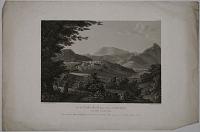
Vue de Cedarhall dans l'Isle d'Antigoa aux Indes occidentales.
Dess. d'ap. nat. par L. Stobwasser. gravé par Hurlimann.
Publié au profit des Missions Evangéliques par une Societé d'amis de l'Evangile, à Basle en Suisse, sous la direction de Birman & Fils. [n.d., 1830.]
Aquatint. 255 x 340mm (10 x 13½"). Edges of plate creased.
A very scarce view of Antigua, showing Cedar Hall, a Moravian church founded on Antigua in 1822. The view was drawn by the Rev. L. Stobwasser for his 'Vues des établissements missionnaires fondés par la communauté évangélique des Frères-Unis'. This work was commissioned by the Moravian Church to promote their work on the island, which was the education of the Negro slaves, including teaching them to read. According to Stobwasser, 'By degrees, the prejudices of the planters against the Negro children being taught to read, which in the beginning were very perceptible, wore away... [giving] the prospect of happier days for the Negros'. [Letter from Stobwasser, quoted by The Religious Intelligencer, 1825.]
[Ref: 22919] £850.00
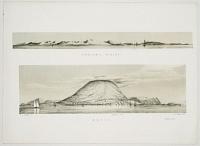
Antigua, S.Side. Nevis.
W.S. Andrews, del. H.C. Trery, Lith.
W. Spreat Exeter [c.1860.]
Tinted lithograph, sheet 270 x 370mm. 10½ x 14½". Small triangular indentation touching edge of top prospect.
Two prospects of West Indian islands: the top one shows the south coast of Antigua, the bottom Nevis, with Charlestown. From Andrews's Illustrations of the West Indies'. Rare: not listed in Abbey Travel.
[Ref: 45842] £280.00
(£336.00 incl.VAT)
![[The Frozen North]](img-thumbnail/jpegs/45584.jpg)
[The Frozen North] Im hohen Norden [...]
[Anon., c.1850]
Engraving, platemark 270 x 315mm (10½ x 12½") very large margins.
Plate from a German travel volume with eleven vignettes of animals and hunting scenes in the Arctic. Central image shows whalers in a small boat fighting off polar bears.
[Ref: 45584] £160.00
(£192.00 incl.VAT)
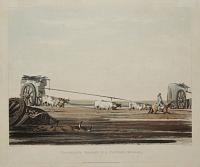
Travelling Wagon in a Pontano (Morass).
E.E. Vidal, Esq. del.t. J. Bluck sculp.t.
London. Published June 1st 1820 at R. Ackermann's, 101 Strand.
Aquatint, printed in colours & hand finished. 255 x 305mm (10 x 12"). Small hole in inscription area, repairs to bottom margin. Small margins.
Two high-wheeled carts drawn by six oxen wading through a bog. Vidal describes these large wheels as necessary because 'no gravel or stone of any kind, not even a pebble, is to be found on the west bank of the river' for 100 miles from Buenos Ayres, making building good roads impossible. Evidence of an unsuccessful crossing is in the foreground. From Emeric Essex Vidal's ''Picturesque Illustrations of Buenos Ayres and Monte Video'', one of the earliest descriptions of Argentinian life. Born c. 1788, Vidal entered the Navy in 1808 and retired in 1862. He visited Buenos Aires and Montevideo twice at the end of 1816 (the year Argentina became independent), returning 1828-9. He was stationed on St Helena 1820-1, during Bonaparte's exile. Abbey Travel: 698. Vidal's text is available on Google Books.
[Ref: 45754] £120.00
(£144.00 incl.VAT)
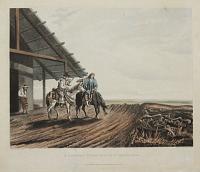
A Country Public House & Travellers.
E.E. Vidal, Esq. del.t. G. Maile & J. Bluck sculp.t.
London. Published Oct.r 1st 1820 at R. Ackermann's, 101 Strand.
Aquatint, printed in colours & hand finished. 255 x 305mm (10 x 12"). Repairs in inscription area and bottom margin.
A 'Pulperia', one five leagues south-west from Buenos Aires, which are described by Vidal as being 'most miserable, dirty hovels, where may be bought a little canna, or spirit distilled from sugarcane'. He writes that horses are so cheap, 'three dollars, the cost of two or three days keep in the city', that they are abused and then abandoned, accounting for the skeleton bottom right. From Emeric Essex Vidal's ''Picturesque Illustrations of Buenos Ayres and Monte Video'', one of the earliest descriptions of Argentinian life. Born c. 1788, Vidal entered the Navy in 1808 and retired in 1862. He visited Buenos Aires and Montevideo twice at the end of 1816 (the year Argentina became independent), returning 1828-9. He was stationed on St Helena 1820-1, during Bonaparte's exile. Abbey Travel: 698. Vidal's text is available on Google Books.
[Ref: 45755] £120.00
(£144.00 incl.VAT)
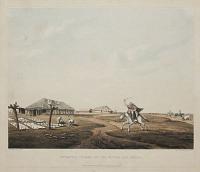
Estantia (Farm) on the River San Pedro.
E.E. Vidal Esq. del.t. Maile & Sutherland sculp.t.
London. Published July 1st 1820 at R. Ackermann's, 101 Strand.
Aquatint, printed in colours & hand finished. 255 x 305mm (10 x 12"), on Whatman Turkey Mill paper dated 1819. Small margins.
A ranch, workers staking out hides to dry and gauchos roping cattle. Vidal describes it as being 16 miles north of Colonia, with no other house within ten miles, with thousands of horses and cattle roaming free. From Emeric Essex Vidal's ''Picturesque Illustrations of Buenos Ayres and Monte Video'', one of the earliest descriptions of Argentinian life. Born c. 1788, Vidal entered the Navy in 1808 and retired in 1862. He visited Buenos Aires and Montevideo twice at the end of 1816 (the year Argentina became independent), returning 1828-9. He was stationed on St Helena 1820-1, during Bonaparte's exile. Abbey Travel: 698.16. Vidal's text is available on Google Books.
[Ref: 45751] £180.00
(£216.00 incl.VAT)
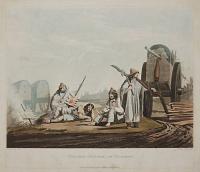
Guachos (Rustics) of Tucuman.
E.E. Vidal, Esq. del.t. G. Maile & J. Bluck sculp.t.
London. Published Sep.r 1st 1820 at R. Ackermann's, 101 Strand.
Aquatint, printed in colours & hand finished. 255 x 305mm (10 x 12"). Narrow margins, trimmed within plate at top, repaired tears to edges,
Four gauchos resting by a fire, their carts behind. Vidal explains that city dwellers call all countrymen 'gauchos' and suggests it derives from the same root as the English 'gawkey' (i.e. awkward and uncooth). Their carts would be unloaded outside the town to avoid congestion inside. From Emeric Essex Vidal's ''Picturesque Illustrations of Buenos Ayres and Monte Video'', one of the earliest descriptions of Argentinian life. Born c. 1788, Vidal entered the Navy in 1808 and retired in 1862. He visited Buenos Aires and Montevideo twice at the end of 1816 (the year Argentina became independent), returning 1828-9. He was stationed on St Helena 1820-1, during Bonaparte's exile. Abbey Travel: 698. Vidal's text is available on Google Books.
[Ref: 45756] £150.00
(£180.00 incl.VAT)
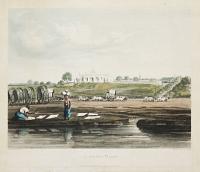
A Quinta (Farm).
E.E. Vidal, Esq. del.t. Sutherland & Maile sculp.t.
London. Published Aug.t 1st 1820 at R. Ackermann's, 101 Strand.
Aquatint, printed in colours & hand finished. 255 x 305mm (10 x 12"). Thread margin at top; bottom of inscription area rubbed, repairs to margins.
A view of an opulent house from the Rio de la Plata, surrounded by fruit trees, with women washing clothes in the foreground, with high-wheeled carts in the middle distance. From Emeric Essex Vidal's ''Picturesque Illustrations of Buenos Ayres and Monte Video'', one of the earliest descriptions of Argentinian life. Born c. 1788, Vidal entered the Navy in 1808 and retired in 1862. He visited Buenos Aires and Montevideo twice at the end of 1816 (the year Argentina became independent), returning 1828-9. He was stationed on St Helena 1820-1, during Bonaparte's exile. Abbey Travel: 698.23. Vidal's text is available on Google Books.
[Ref: 45752] £180.00
(£216.00 incl.VAT)
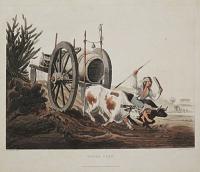
Water Cart.
E.E. Vidal, Esq. del.t. G. Maile & J. Bluck sculp.t.
London. Published Aug.t 1st 1820 at R. Ackermann's, 101 Strand.
Aquatint, printed in colours & hand finished. 255 x 305mm (10 x 12"). Narrow margins, mount burn around image, repairs to bottom margin.
A high-wheeled cart pulled by two oxen, driven down a steep bank by a gaucho riding on the yoke. The flat plains of Argentine mean that no canals could be built to supply Buenos Aires with drinking water, resulting in large numbers of water carts From Emeric Essex Vidal's ''Picturesque Illustrations of Buenos Ayres and Monte Video'', one of the earliest descriptions of Argentinian life. Born c. 1788, Vidal entered the Navy in 1808 and retired in 1862. He visited Buenos Aires and Montevideo twice at the end of 1816 (the year Argentina became independent), returning 1828-9. He was stationed on St Helena 1820-1, during Bonaparte's exile. Abbey Travel: 698. Vidal's text is available on Google Books.
[Ref: 45757] £140.00
(£168.00 incl.VAT)
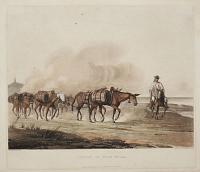
Convoy of Wine Mules.
E.E. Vidal, Esq. del.t. G. Maile & T. Sutherland sculp.t.
London. Published Aug.t 1st 1820 at R. Ackermann's, 101 Strand.
Aquatint, printed in colours & hand finished. 255 x 305mm (10 x 12"), on Whatman Turkey Mill paper dated 1819. Mount burn around image.
Early wine related image showing a rider on horse leading a convoy of mules, each laden with two barrels of wine. Vidal saw these coming from Mendoza in Cuyo, describing the convoy as between two-and-three hundred mules, each with two ten-gallon casks, accompanied by only three or four riders. From Emeric Essex Vidal's ''Picturesque Illustrations of Buenos Ayres and Monte Video'', one of the earliest descriptions of Argentinian life. Born c. 1788, Vidal entered the Navy in 1808 and retired in 1862. He visited Buenos Aires and Montevideo twice at the end of 1816 (the year Argentina became independent), returning 1828-9. He was stationed on St Helena 1820-1, during Bonaparte's exile. Abbey Travel: 698.19. Vidal's text is available on Google Books.
[Ref: 45753] £190.00
(£228.00 incl.VAT)
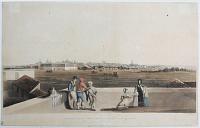
General View of Buenos Ayres, from the Plaza de Toros.
E.E. Vidal Esq. del.t. G.Maile & T. Sutherland sculp.t.
London. Published Oct.r 1st 1820 at R. Ackermann's, 101 Strand.
Aquatint, printed in colours & hand finished. Sheet 310 x 490mm. Folded as issued, trimmed within plate, surface scuffed, paper toned, laid on card.
From Emeric Essex Vidal's ''Picturesque Illustrations of Buenos Ayres and Monte Video'', one of the earliest descriptions of Argentinian life. Born c. 1788, Vidal entered the Navy in 1808 and retired in 1862. He visited Buenos Aires and Montevideo twice at the end of 1816 (the year Argentina became independent), returning 1828-9. He was stationed on St Helena 1820-1, during Bonaparte's exile. Abbey Travel: 698. Vidal's text is available on Google Books.
[Ref: 45946] £160.00
(£192.00 incl.VAT)
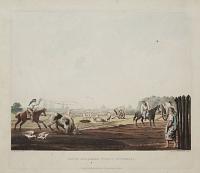
South Matadero (Public Butchery).
E.E. Vidal Esq. del.t. Bluck sculp.t.
London. Published July 1st 1820 at R. Ackermann's, 101 Strand.
Aquatint, printed in colours & hand finished. 255 x 305mm (10 x 12"). Mount burn around image, repaired tear entering plate, other repairs in margins, colour faded.
One of the four mataderos around Buenos Aires, a field in which cattle are being lassoed by horsemen and slaughtered. The city's skyline is in the background. From Emeric Essex Vidal's ''Picturesque Illustrations of Buenos Ayres and Monte Video'', one of the earliest descriptions of Argentinian life. Born c. 1788, Vidal entered the Navy in 1808 and retired in 1862. He visited Buenos Aires and Montevideo twice at the end of 1816 (the year Argentina became independent), returning 1828-9. He was stationed on St Helena 1820-1, during Bonaparte's exile. Abbey Travel: 698. Vidal's text is available on Google Books.
[Ref: 45748] £220.00
(£264.00 incl.VAT)
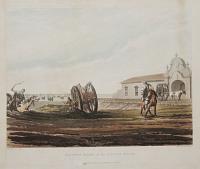
Shipping Hides at the Custom House.
E.E. Vidal Esq. del.t. G. Maile & J. Bluck sculp.t.
[Lon]don. Published July 1st 1820 at R. Ackermann's, 101 Strand.
Aquatint, printed in colours & hand finished. 255 x 305mm (10 x 12"), Faint backboard burn in sky, loss to inscription area and bottom margin filled, laid on card,
The Custom House at Buenos Aires, with a big-wheeled cart going down an unpaved slope down a 12-foot to the riverside. From Emeric Essex Vidal's ''Picturesque Illustrations of Buenos Ayres and Monte Video'', one of the earliest descriptions of Argentinian life. Born c. 1788, Vidal entered the Navy in 1808 and retired in 1862. He visited Buenos Aires and Montevideo twice at the end of 1816 (the year Argentina became independent), returning 1828-9. He was stationed on St Helena 1820-1, during Bonaparte's exile. Abbey Travel: 698. Vidal's text is available on Google Books.
[Ref: 45749] £140.00
(£168.00 incl.VAT)
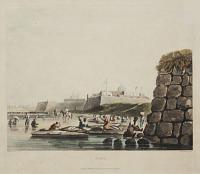
Fort.
E.E. Vidal Esq. del.t. T. Sutherland sculp.t
London. Published July 1st 1820 at R. Ackermann's, 101 Strand.
Aquatint, printed in colours & hand finished. 255 x 305mm (10 x 12").
The Fort, residence of the Chief Director of the United Provinces, on the edge of the river at Buenos Aires. Vidal describes the spot as a popular spot to bathe, both men and women. In the background are the churches of San Francisco and Dan Domingo. From Emeric Essex Vidal's ''Picturesque Illustrations of Buenos Ayres and Monte Video'', one of the earliest descriptions of Argentinian life. Born c. 1788, Vidal entered the Navy in 1808 and retired in 1862. He visited Buenos Aires and Montevideo twice at the end of 1816 (the year Argentina became independent), returning 1828-9. He was stationed on St Helena 1820-1, during Bonaparte's exile. Abbey Travel: 698.3. Vidal's text is available on Google Books.
[Ref: 45750] £160.00
(£192.00 incl.VAT)
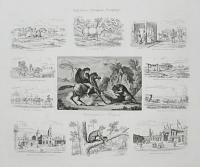
Argentina, Paraguay, Uruguay Jaguarjagd in Paraguay [...]
[Anon., c.1850]
Engraving, platemark 270 x 315mm (10½ x 12½") very large margins.
Plate from a German travel volume with a scene of jaguar-hunting in Paraguay surrounded by ten vignettes from Argentina, Paraguay and Uruguay, including views in Buenos Aires and Mendoza.
[Ref: 45581] £150.00
(£180.00 incl.VAT)
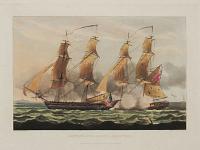
Capture of the Argus, Aug.t. 14.th. 1813.
Painted by T. Whitcombe. Engraved by T. Sutherland.
Publish'd Feb.y. 1. 1817 at 48 Strand for J. Jenkin's Naval Achievements.
Handcoloured aquatint. With letterpress. Plate: 300 x 220, (12 x 8¾"). Very large margins.
A naval battle scene showing the capture of the American brig Argus under the command of Lieutenant W. H. Allen by the British brig Pelican under the command of Commander J. F. Maples off St. David's lighthouse. From 'The Naval Achievements of Great Britain from the Year 1793-1817' by J.Jenkins. Parker: 232.
[Ref: 39372] £360.00
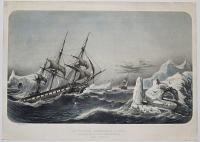
Les Corvettes L'Astrolabe et la Zélée. aux ordres du Ct. Dumont D'Urville, dans le coup de vent du Janvier 1840. Parages de cercle Polaire Antarctique.
Dess. et Lith. par Louis Le Breton.
Imp. Auguste Bry, 114 r. du Bac, Paris. [n.d., c.1845.]
Tinted lithograph with hand colour. Sheet 450 x 635mm (17¾ x 25"). Trimmed at bottom, losing publication line. Nicks in edges.
One of two very rare separately-published lithographs, this showing the Astrolabe and the Zélée in a hurricane, surrounded by icebergs and penguins. In 1837 Jules Dumont d'Urville (1790-1842) was sent to try to claim the southern magnetic pole for France. He returned to home in 1840 and was killed in France's first railway disaster two years later.
[Ref: 45618] £850.00
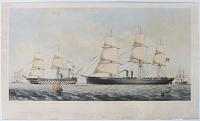
To His Excellency George M. Dallas, Envoy Extraordinary and Minister Plenipotentiary from the United States, this Print of the Vessels engaged in laying the Atlantic Telegraph Cable, is respectfully dedicated by his most obedient Servant, [...]
Josiah Taylor Del. Vincent Brooks Lith.
London: Published August 4th 1857, by W. Foster, 114, Fenchurch Street.
A large and fine coloured lithograph. Printed area 530 x 880mm (20¾ x 34½"). Trimmed into inscription area, losing dedicatee, a few repaired tears.
The first attempt to lay a transatlantic telegraph cable, beaten when the cable kept breaking. The British ships are named as 'Agamemnon' & 'Leopard', the American 'Niagara' & 'Susquehanna'.
[Ref: 45849] £1,800.00
![Bermudian Boats. Ireland Island in the Distance [ms]](img-thumbnail/jpegs/44513.jpg)
Bermudian Boats. Ireland Island in the Distance [ms]
T. Dean [?] [in image lower left; c.1820]
Watercolour, sheet 140 x 165mm (5½ x 6½"). Glued to backing sheet.
View off the coast of Bermuda in the Atlantic Ocean.
[Ref: 44513] £650.00
![[Emerald tree boa] The Green Boa.](img-thumbnail/jpegs/45780.jpg)
[Emerald tree boa] The Green Boa. Xiphosoma Caninum.
[Lithographed by Joseph Smit after Joseph Wolf.]
[London: Henry Graves & Company, 1861-1867.]
Coloured lithograph, trimmed to image and mounted on card with gilt title, as issued. Printed area 240 x 350mm (9½ x 13¾"). Some slight cockling of paper.
Corallus caninus, a non-venonous snake of the South American rainforests, named for its fangs, proportionately larger than those of any other non-venomous snake. From 'Zoological Sketches by Joseph Wolf. Made for the Zoological Society of London, from animals in their vivarium, in the Regent's Park', issued in two parts, 1861 and 1867. Joseph Wolf (1820-99), a German artist, specialized in natural history illustration, and is considered one of the great pioneers of wildlife art, having depicted animals accurately in lifelike postures. He worked with John Gould on 'The Birds of Great Britain'. Sir Edwin Landseer considered him 'without exception, the best all-round animal artist who ever lived'.
[Ref: 45780] £190.00
(£228.00 incl.VAT)
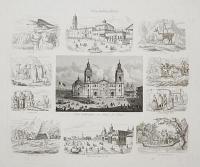
Peru, Bolivia, Chile. Die Cathedrale in Lima in Peru [...]
[Anon., c.1850]
Engraving, platemark 270 x 315mm (10½ x 12½") very large margins.
Plate from a German travel volume with a view of Lima Cathedral surrounded by ten vignettes including views in Santiago, Chile and Chuquisaca, Bolivia.
[Ref: 45586] £180.00
(£216.00 incl.VAT)

Defeat and Death of General Braddock in North America. Engraved for Russell's History of England.
Dodd delin.t. Edm.d Scott Sculp.
[London: J. Cooke, 1779.]
Engraving. 305 x 195mm (12 x 7¾"). Slight text offset, bit messy.
General Edward Braddock (1695-1755) being shot from his horse in a battle with the French troops occupying the Ohio River Valley during the French and Indian War (part of the Seven Years' War). George Washington presided at the burial service near Great Meadows and kept Braddock's ceremonial sash with him for the rest of his life.
[Ref: 45850] £95.00
(£114.00 incl.VAT)
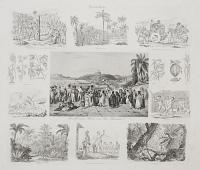
Brasilien. Ansicht eines Theils von Rio Janeiro [...]
[Anon., c.1850]
Engraving, platemark 270 x 315mm (10½ x 12½"), with very large margins.
Plate from a German travel volume with a view of Rio de Janeiro surrounded by ten vignettes showing the nature of Brazil and the labour and punishment of slaves. The central image is copied from a lithograph by Victor Adam after J.M. Rugendas published in his 'Voyage pittoresque dans le Brésil' (1827-35). There the lithograph was described as taken from the Mosteiro de São Bento (Monastery of St Benedict). For Rugendas' view of Rio de Janeiro see ref. 45553.
[Ref: 45587] £230.00
(£276.00 incl.VAT)
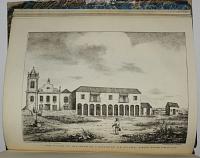
[A History of the Brazil; comprising its Geography, Commerce, Colonization, Aboriginal Inhabitants, &c. &c. &c. by James Henderson, Recently from South America. Illustrated with Twenty-Eight Plates and Two Maps.]
[London: Printed for the Author, and Published by Longman, Hurst, Rees, Orme, and Brown, Paternoster Row. 1821.]
4to, original half calf gilt, marbled boards, edges and endpapers; pp. iii-xiv + 522; 2 folding maps, 26 lithographic plates (of 28), two extra engraved plates of Brazil. Boards detached, lacking title and two plates.
A study of Brazil illustrated by sketches by James Henderson (1783?-1848), who travelled to Rio de Janeiro hoping to obtain a position with the British Government. The views, lithographed by C. Shoesmith and printed by Hullmandel, are some of the earliest lithographic book illustrations. This volume includes Plate 23, which only appears in Subscriber's copies.
[Ref: 32175] £1,600.00
view all images for this item
![[13 postcards of the Aimoré people of Brazil, from photographs by Walter Garbe.] Série: Indios Botucudos...](img-thumbnail/jpegs/45659.jpg)
[13 postcards of the Aimoré people of Brazil, from photographs by Walter Garbe.] Série: Indios Botucudos...
[n.d., c.1930.]
13 collotype postcards, each 140 x 90mm (5½ x 3½").
Photographs of the Aimoré tribes of Espírito Santo, called Botocudo in Portuguese for 'plugging' their ears and lower lips with plugs to extend them. It shows them using their bows, spears, blowpipes and flutes. Walter Garbe photographed the tribesmen on the left bank of the Doce River betweeen March and May 1909.
[Ref: 45659] £350.00
view all images for this item
![[Black man and woman from Bahia]](img-thumbnail/jpegs/45572.jpg)
[Black man and woman from Bahia] Nègre et nègresse de Bahia.
Dess d'ap nat. par Rugendas Lith. par Maurin
Lith. de Engelmann, rue du Faub Montmartre No.6 a Paris [1827-35]
Lithograph, printed area 320 x 245mm (12½ x 9½").
Man and woman from the state of Bahia in the north-east of Brazil. Plate from 'Voyage pittoresque au Brésil' (1827-35), a volume of lithographs after drawings by Johann Moritz Rugendas (1802-58). Rugendas, who came from a family including several notable artists, travelled to Brazil in 1821 as draughtsman with the Russian diplomat Baron de Langsdorff’s scientific expedition. However, Rugendas left the expedition, discovering Brazil for himself and returning to Europe in 1825 with the extraordinary collection of drawings which provided the material for 'Voyage pittoresque'. Encouraged by the German scientist and explorer Alexander von Humboldt, Rugendas returned to Latin America in 1831, living until 1845 in Mexico and Chile with shorter stays in Argentina, Peru, Bolivia, and Uruguay, and drawing and painting prolifically throughout this time. He returned to Bavaria, where nearly 3000 drawings and paintings were acquired by the local government, but he then went back to live in Brazil between 1845 and 1846.
[Ref: 45572] £320.00
![[Black women from Rio de Janeiro]](img-thumbnail/jpegs/45571.jpg)
[Black women from Rio de Janeiro] Nègresses de Rio-Janeiro
Dess d'ap nat. par Rugendas Lith. par Maurin
Lith. de Engelmann, rue du Faub Montmartre No.6 a Paris [1827-35]
Lithograph, printed area 320 x 240mm (12½ x 9½").
Plate from 'Voyage pittoresque au Brésil' (1827-35), a volume of lithographs after drawings by Johann Moritz Rugendas (1802-58). Rugendas, who came from a family including several notable artists, travelled to Brazil in 1821 as draughtsman with the Russian diplomat Baron de Langsdorff’s scientific expedition. However, Rugendas left the expedition, discovering Brazil for himself and returning to Europe in 1825 with the extraordinary collection of drawings which provided the material for 'Voyage pittoresque'. Encouraged by the German scientist and explorer Alexander von Humboldt, Rugendas returned to Latin America in 1831, living until 1845 in Mexico and Chile with shorter stays in Argentina, Peru, Bolivia, and Uruguay, and drawing and painting prolifically throughout this time. He returned to Bavaria, where nearly 3000 drawings and paintings were acquired by the local government, but he then went back to live in Brazil between 1845 and 1846.
[Ref: 45571] £320.00
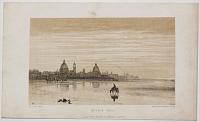
Buenos Ayres.
R.Elwes del et lith. Hullmandel & Walton Lithog.
London: Hurst & Blackett Great Marlborough Street [c.1854]
Lithograph, printed area 125 x 180mm (5 x 7").
Buenos Aires, capital of Argentina by Robert Elwes (1819-1878) a Victorian traveller. See 45593
[Ref: 45595] £160.00
(£192.00 incl.VAT)
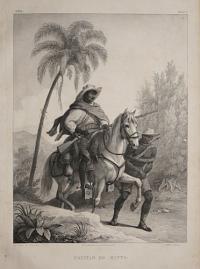
Capitao do matto
Dess d'ap nat. par Rugendas Lith. par Zwinger
Lith. de Engelmann, rue du Faub Montmartre No.6 a Paris [1827-35]
Lithograph, printed area 405 x 280mm (16 x 11").
A 'capitão do mato', an employee of a factory or plantation charged with recovering runaway slaves. Plate from 'Voyage pittoresque au Brésil' (1827-35), a volume of lithographs after drawings by Johann Moritz Rugendas (1802-58). Rugendas, who came from a family including several notable artists, travelled to Brazil in 1821 as draughtsman with the Russian diplomat Baron de Langsdorff’s scientific expedition. However, Rugendas left the expedition, discovering Brazil for himself and returning to Europe in 1825 with the extraordinary collection of drawings which provided the material for 'Voyage pittoresque'. Encouraged by the German scientist and explorer Alexander von Humboldt, Rugendas returned to Latin America in 1831, living until 1845 in Mexico and Chile with shorter stays in Argentina, Peru, Bolivia, and Uruguay, and drawing and painting prolifically throughout this time. He returned to Bavaria, where nearly 3000 drawings and paintings were acquired by the local government, but he then went back to live in Brazil between 1845 and 1846.
[Ref: 45578] £260.00
(£312.00 incl.VAT)
![[Corcovado mountain and the Catete neighbourhood, Rio de Janeiro]](img-thumbnail/jpegs/45557.jpg)
[Corcovado mountain and the Catete neighbourhood, Rio de Janeiro] Vue de la montagne de Corecovado et du faubourg de Cadete, prise de la Carrière
Dess d'ap nat. par Rugendas Deroi del.
Lith. de Engelmann, rue du faub Montmartre No.6 [1827-35]
Lithograph, printed area 280 x 365mm (11 x 14½").
View of mountains in Rio de Janeiro including Corcovado (now distinguished by the famous 'Christ the Redeemer' statue), with the neighbourhood of Catete in the middle-ground. Slaves working in a quarry in foreground. Plate from 'Voyage pittoresque au Brésil' (1827-35), a volume of lithographs after drawings by Johann Moritz Rugendas (1802-58). Rugendas, who came from a family including several notable artists, travelled to Brazil in 1821 as draughtsman with the Russian diplomat Baron de Langsdorff’s scientific expedition. However, Rugendas left the expedition, discovering Brazil for himself and returning to Europe in 1825 with the extraordinary collection of drawings which provided the material for 'Voyage pittoresque'. Encouraged by the German scientist and explorer Alexander von Humboldt, Rugendas returned to Latin America in 1831, living until 1845 in Mexico and Chile with shorter stays in Argentina, Peru, Bolivia, and Uruguay, and drawing and painting prolifically throughout this time. He returned to Bavaria, where nearly 3000 drawings and paintings were acquired by the local government, but he then went back to live in Brazil between 1845 and 1846.
[Ref: 45557] £260.00
(£312.00 incl.VAT)
![[Fields by the das Velhas river in the state of Minas Gerais, Brazil]](img-thumbnail/jpegs/45562.jpg)
[Fields by the das Velhas river in the state of Minas Gerais, Brazil] Campos sur les bords du rio das velhas. dans la province de Minaes Geraes.
Bonington del. fig. par V. Adam. dess d'ap nat. par Rugendas
Lith. de Engelmann, Rue Louis-le-Grand No 27 a Paris
Lithograph, printed area 285 x 345mm (11¼ x 13½").
Landscape in Minas Gerais, Brazil, with hunting in foreground. Plate from 'Voyage pittoresque au Brésil' (1827-35), a volume of lithographs after drawings by Johann Moritz Rugendas (1802-58). Rugendas, who came from a family including several notable artists, travelled to Brazil in 1821 as draughtsman with the Russian diplomat Baron de Langsdorff’s scientific expedition. However, Rugendas left the expedition, discovering Brazil for himself and returning to Europe in 1825 with the extraordinary collection of drawings which provided the material for 'Voyage pittoresque'. Encouraged by the German scientist and explorer Alexander von Humboldt, Rugendas returned to Latin America in 1831, living until 1845 in Mexico and Chile with shorter stays in Argentina, Peru, Bolivia, and Uruguay, and drawing and painting prolifically throughout this time. He returned to Bavaria, where nearly 3000 drawings and paintings were acquired by the local government, but he then went back to live in Brazil between 1845 and 1846. This particular plate is of added interest owing to the involvement of the landscape painter Richard Parkes Bonington (1802-28) as a draughtsman. Bonington lived in Paris for part of his short career, sharing a studio with Delacroix, and despite his death from tuberculosis at the age of 25, his work has consistently been held in high esteem.
[Ref: 45562] £280.00
(£336.00 incl.VAT)
![[Inhomirim river in the state of Rio de Janeiro]](img-thumbnail/jpegs/45563.jpg)
[Inhomirim river in the state of Rio de Janeiro] Rio Jnhomerim, dans la Baie de Rio de Janeiro
Villeneuve del. fig. par V. Adam. dess d'ap nat. par Rugendas
Lith. de Engelmann, Rue Louis-le-Grand No 27 a Paris
Lithograph, printed area 295 x 340mm (11¾ x 13½").
Landscape in the state of Rio de Janeiro, with hunters shooting crocodile in foreground. Plate from 'Voyage pittoresque au Brésil' (1827-35), a volume of lithographs after drawings by Johann Moritz Rugendas (1802-58). Rugendas, who came from a family including several notable artists, travelled to Brazil in 1821 as draughtsman with the Russian diplomat Baron de Langsdorff’s scientific expedition. However, Rugendas left the expedition, discovering Brazil for himself and returning to Europe in 1825 with the extraordinary collection of drawings which provided the material for 'Voyage pittoresque'. Encouraged by the German scientist and explorer Alexander von Humboldt, Rugendas returned to Latin America in 1831, living until 1845 in Mexico and Chile with shorter stays in Argentina, Peru, Bolivia, and Uruguay, and drawing and painting prolifically throughout this time. He returned to Bavaria, where nearly 3000 drawings and paintings were acquired by the local government, but he then went back to live in Brazil between 1845 and 1846. This particular plate is of added interest owing to the involvement of the landscape painter Richard Parkes Bonington (1802-28) as a draughtsman. Bonington lived in Paris for part of his short career, sharing a studio with Delacroix, and despite his death from tuberculosis at the age of 25, his work has consistently been held in high esteem.
[Ref: 45563] £320.00
![[View taken from the Monastery of St Benedict, Rio de Janeiro]](img-thumbnail/jpegs/45553.jpg)
[View taken from the Monastery of St Benedict, Rio de Janeiro] Vue prise devant l'élise de San-Bendo à Rio Janeiro
V. Adam del.t Dess d'ap nat. par Rugendas
Lith. de Engelmann, rue du F. Montmartre No.6 [1827-35]
Lithograph, printed area 250 x 320mm (9¾ x 12½").
View showing the Rio de Janeiro coastline, taken from the Mosteiro de São Bento (Monastery of St Benedict). Plate from 'Voyage pittoresque au Brésil' (1827-35), a volume of lithographs after drawings by Johann Moritz Rugendas (1802-58). Rugendas, who came from a family including several notable artists, travelled to Brazil in 1821 as draughtsman with the Russian diplomat Baron de Langsdorff’s scientific expedition. However, Rugendas left the expedition, discovering Brazil for himself and returning to Europe in 1825 with the extraordinary collection of drawings which provided the material for 'Voyage pittoresque'. Encouraged by the German scientist and explorer Alexander von Humboldt, Rugendas returned to Latin America in 1831, living until 1845 in Mexico and Chile with shorter stays in Argentina, Peru, Bolivia, and Uruguay, and drawing and painting prolifically throughout this time. He returned to Bavaria, where nearly 3000 drawings and paintings were acquired by the local government, but he then went back to live in Brazil between 1845 and 1846.
[Ref: 45553] £230.00
(£276.00 incl.VAT)
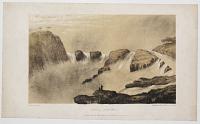
Paulo Affonso.
R.Elwes del et lith. Hullmandel & Walton, Lithog.
London: Hurst & Blackett Great Marlborough Street [c.1854]
Lithograph and tintstone, printed area 125 x 180mm (4½ x 7").
Spectacular view of the São Francisco River where it passes through the city of Paulo Afonso in the state of Bahia, Brazil by Robert Elwes (1819-1878) a Victorian traveller. See 45595
[Ref: 45593] £90.00
(£108.00 incl.VAT)
![[Military and slaves on boats, Rio de Janeiro coastline]](img-thumbnail/jpegs/45554.jpg)
[Military and slaves on boats, Rio de Janeiro coastline] Braia dos Mineiros à Rio-Janeiro
V. Adam del.t Dess d'ap nat. par Rugendas
Lith. de Engelmann, rue du F. Montmartre No.6 [1827-35]
Lithograph, printed area 260 x 330mm (10¼ x 13").
Stretch of Rio de Janeiro coastline formerly known as the 'Praia dos Mineiros'. Plate from 'Voyage pittoresque au Brésil' (1827-35), a volume of lithographs after drawings by Johann Moritz Rugendas (1802-58). Rugendas, who came from a family including several notable artists, travelled to Brazil in 1821 as draughtsman with the Russian diplomat Baron de Langsdorff’s scientific expedition. However, Rugendas left the expedition, discovering Brazil for himself and returning to Europe in 1825 with the extraordinary collection of drawings which provided the material for 'Voyage pittoresque'. Encouraged by the German scientist and explorer Alexander von Humboldt, Rugendas returned to Latin America in 1831, living until 1845 in Mexico and Chile with shorter stays in Argentina, Peru, Bolivia, and Uruguay, and drawing and painting prolifically throughout this time. He returned to Bavaria, where nearly 3000 drawings and paintings were acquired by the local government, but he then went back to live in Brazil between 1845 and 1846.
[Ref: 45554] £230.00
(£276.00 incl.VAT)
![[Praia Rodrigues, near Rio de Janeiro]](img-thumbnail/jpegs/45564.jpg)
[Praia Rodrigues, near Rio de Janeiro] Praya Rodriguez. Près de Rio de Janeiro
Villeneuve del. fig. par V. Adam. dess d'ap nat. par Rugendas
Lith. de Engelmann, Rue Louis-le-Grand No 27 a Paris
Lithograph, printed area 295 x 340mm (11¾ x 13½").
Landscape in the state of Rio de Janeiro, with hunters in foreground. Plate from 'Voyage pittoresque au Brésil' (1827-35), a volume of lithographs after drawings by Johann Moritz Rugendas (1802-58). Rugendas, who came from a family including several notable artists, travelled to Brazil in 1821 as draughtsman with the Russian diplomat Baron de Langsdorff’s scientific expedition. However, Rugendas left the expedition, discovering Brazil for himself and returning to Europe in 1825 with the extraordinary collection of drawings which provided the material for 'Voyage pittoresque'. Encouraged by the German scientist and explorer Alexander von Humboldt, Rugendas returned to Latin America in 1831, living until 1845 in Mexico and Chile with shorter stays in Argentina, Peru, Bolivia, and Uruguay, and drawing and painting prolifically throughout this time. He returned to Bavaria, where nearly 3000 drawings and paintings were acquired by the local government, but he then went back to live in Brazil between 1845 and 1846. This particular plate is of added interest owing to the involvement of the landscape painter Richard Parkes Bonington (1802-28) as a draughtsman. Bonington lived in Paris for part of his short career, sharing a studio with Delacroix, and despite his death from tuberculosis at the age of 25, his work has consistently been held in high esteem.
[Ref: 45564] £320.00
![[View of Rio de Janeiro from the harbour]](img-thumbnail/jpegs/45560.jpg)
[View of Rio de Janeiro from the harbour] Vue de Rio-Janeiro. prise de la Rade.
Dess d'ap nat. par Rugendas Sabatier del.
Lith. de Engelmann, rue du faub Montmartre No.6 [1827-35]
Lithograph, printed area 300 x 405mm (11¾ x 16").
Plate from 'Voyage pittoresque au Brésil' (1827-35), a volume of lithographs after drawings by Johann Moritz Rugendas (1802-58). Rugendas, who came from a family including several notable artists, travelled to Brazil in 1821 as draughtsman with the Russian diplomat Baron de Langsdorff's scientific expedition. However, Rugendas left the expedition, discovering Brazil for himself and returning to Europe in 1825 with the extraordinary collection of drawings which provided the material for 'Voyage pittoresque'. Encouraged by the German scientist and explorer Alexander von Humboldt, Rugendas returned to Latin America in 1831, living until 1845 in Mexico and Chile with shorter stays in Argentina, Peru, Bolivia, and Uruguay, and drawing and painting prolifically throughout this time. He returned to Bavaria, where nearly 3000 drawings and paintings were acquired by the local government, but he then went back to live in Brazil between 1845 and 1846.
[Ref: 45560] £450.00
![[Entrance to the Rio de Janeiro harbour]](img-thumbnail/jpegs/45561.jpg)
[Entrance to the Rio de Janeiro harbour] Entrée de la rade de Rio-Janeiro.
Dess d'ap nat. par Rugendas Bonington del.
Lith. de Engelmann, rue du faub Montmartre No.6 [1827-35]
Lithograph, printed area 260 x 340mm (10¼ x 13½").
Plate from 'Voyage pittoresque au Brésil' (1827-35), a volume of lithographs after drawings by Johann Moritz Rugendas (1802-58). Rugendas, who came from a family including several notable artists, travelled to Brazil in 1821 as draughtsman with the Russian diplomat Baron de Langsdorff’s scientific expedition. However, Rugendas left the expedition, discovering Brazil for himself and returning to Europe in 1825 with the extraordinary collection of drawings which provided the material for 'Voyage pittoresque'. Encouraged by the German scientist and explorer Alexander von Humboldt, Rugendas returned to Latin America in 1831, living until 1845 in Mexico and Chile with shorter stays in Argentina, Peru, Bolivia, and Uruguay, and drawing and painting prolifically throughout this time. He returned to Bavaria, where nearly 3000 drawings and paintings were acquired by the local government, but he then went back to live in Brazil between 1845 and 1846. This particular plate is of added interest owing to the involvement of the landscape painter Richard Parkes Bonington (1802-28) as a draughtsman. Bonington lived in Paris for part of his short career, sharing a studio with Delacroix, and despite his death from tuberculosis at the age of 25, his work has consistently been held in high esteem.
[Ref: 45561] £360.00
![[View of Rio de Janeiro from the Carioca aqueduct]](img-thumbnail/jpegs/45559.jpg)
[View of Rio de Janeiro from the Carioca aqueduct] Vue de Rio-Janeiro. prise de l'Acqueduc.
Dess d'ap nat. par Rugendas Villeneuve del. fig. par V. Adam
Lith. de Engelmann, rue du faub Montmartre No.6 [1827-35]
Lithograph, printed area 280 x 355mm (11 x 14").
View of Rio de Janeiro with leisurely hunting party in foreground. Plate from 'Voyage pittoresque au Brésil' (1827-35), a volume of lithographs after drawings by Johann Moritz Rugendas (1802-58). Rugendas, who came from a family including several notable artists, travelled to Brazil in 1821 as draughtsman with the Russian diplomat Baron de Langsdorff’s scientific expedition. However, Rugendas left the expedition, discovering Brazil for himself and returning to Europe in 1825 with the extraordinary collection of drawings which provided the material for 'Voyage pittoresque'. Encouraged by the German scientist and explorer Alexander von Humboldt, Rugendas returned to Latin America in 1831, living until 1845 in Mexico and Chile with shorter stays in Argentina, Peru, Bolivia, and Uruguay, and drawing and painting prolifically throughout this time. He returned to Bavaria, where nearly 3000 drawings and paintings were acquired by the local government, but he then went back to live in Brazil between 1845 and 1846.
[Ref: 45559] £360.00


![[Schooner Yacht America off Dunnose Isle of Wight.]](img-thumbnail/jpegs/44722.jpg)

![[American Revolution.] A New and Accurate Map of the Chief Parts of South Carolina, and Georgia, from the Best Authorities.](img-thumbnail/jpegs/43272.jpg)
![[American Revolution.] An Accurate Map of Rhode Island,](img-thumbnail/jpegs/43271.jpg)
![[American Revolution.] A New and Accurate Map of the Province of New York](img-thumbnail/jpegs/43269.jpg)
![[American Revolution.] A New and Accurate Map of Virginia,](img-thumbnail/jpegs/43273.jpg)





![[The Frozen North]](img-thumbnail/jpegs/45584.jpg)















![Bermudian Boats. Ireland Island in the Distance [ms]](img-thumbnail/jpegs/44513.jpg)
![[Emerald tree boa] The Green Boa.](img-thumbnail/jpegs/45780.jpg)




![[13 postcards of the Aimoré people of Brazil, from photographs by Walter Garbe.] Série: Indios Botucudos...](img-thumbnail/jpegs/45659.jpg)
![[Black man and woman from Bahia]](img-thumbnail/jpegs/45572.jpg)
![[Black women from Rio de Janeiro]](img-thumbnail/jpegs/45571.jpg)


![[Corcovado mountain and the Catete neighbourhood, Rio de Janeiro]](img-thumbnail/jpegs/45557.jpg)
![[Fields by the das Velhas river in the state of Minas Gerais, Brazil]](img-thumbnail/jpegs/45562.jpg)
![[Inhomirim river in the state of Rio de Janeiro]](img-thumbnail/jpegs/45563.jpg)
![[View taken from the Monastery of St Benedict, Rio de Janeiro]](img-thumbnail/jpegs/45553.jpg)

![[Military and slaves on boats, Rio de Janeiro coastline]](img-thumbnail/jpegs/45554.jpg)
![[Praia Rodrigues, near Rio de Janeiro]](img-thumbnail/jpegs/45564.jpg)
![[View of Rio de Janeiro from the harbour]](img-thumbnail/jpegs/45560.jpg)
![[Entrance to the Rio de Janeiro harbour]](img-thumbnail/jpegs/45561.jpg)
![[View of Rio de Janeiro from the Carioca aqueduct]](img-thumbnail/jpegs/45559.jpg)